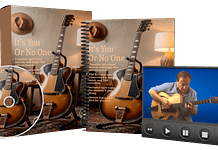This post may contain affiliate links. As an Amazon associate, Google associate as well as associate for other programs, Guitar & Music Institute may earn commissions from qualifying purchases.
How To Tune A Guitar – The Options Available
Gone are the days when tuning a guitar could only be done by ear. Well, it was done by hand, but you used your ears to guess when you were actually in tune. The only other option used when working out how to tune a guitar was to use another instrument to tune too. This caused problems as well. The guitar is a transposing instrument so it sounds an octave lower than written. Making sure the French horn player knows what you are going on about could be tricky. Also, what if you tune to a piano and it is out of tune?
What Do We Have Now To Tune Guitars?
Now, there are a huge amount of options available to you. There is the way that just described above. In the twenty first century there are a lot more options available. There are guitar tuner pedals, guitar apps for tuning, pitch pipes and tuning forks. GMI – Guitar & Music Institute thought it was time to have a good look at what’s out there and go through the whole guitar tuning experience.
Relative And Concert Pitch Tuning
At this point it might be a good idea for us to split up tuning a guitar into two different types. You can tune your guitar relative to itself. That is, you use the ear method outlined below to tune the guitar to the lowest string. It’s usually a good idea to tune to the lowest string. The guitar may now be in tune, however, it may not be tuned to concert pitch.
What’s Concert Pitch?
Concert pitch is defined as follows. The A note above middle C (on a piano) is tuned and resonates at 440 Hertz (Hz). In 1926 the American Standards Association decided that this would be the standard. Before this, countries had different ideas of what concert pitch should actually be. It’s interesting to note that some people state that the universe vibrates at a frequency of 432 Hz, interesting but perhaps not that important to tuning the guitar.
Are You Just Tuning Your Guitar Relatively?
The point of all this is the following. If you tune your guitar to itself using the “ear” method below without an external device to help you locate concert pitch, then you are tuning your guitar relative to itself. You will probably not be in concert pitch meaning that if you play with other musicians who are in concert pitch it will sound pretty terrible. That being said, if you are not playing with other musicians, it’s better to be in tune relatively than not at all and that is what the next section will teach you. As an aside, some people have “perfect pitch”.
What Is Perfect Pitch?
Perfect pitch is sometimes referred to as absolute pitch. It’s quite a big subject but at it’s core it means that a human can hear and identify exactly any chord notes and tones without the aid of an external device. Musicians who have perfect pitch are few and far between. If you have perfect pitch you don’t need to bother continuing to read this article as it’s all hard wired into your head already!
How To Tune A Guitar The “Ear” Method
The ear method means that you either use a tuning fork to tune one string to concert pitch then tune up using the following method. Or, you will just tune your guitar relative to one of your strings; usually string six. Watch the following video to see how to tune the guitar in this way.
Tuning The Guitar Using A Tuning Fork
The next method builds on the previous method, but by using a tuning fork we can ensure that the guitar is tuned to perfect pitch. As mentioned earlier, the note A resonates at 440 Hz and is the A above middle C on the piano keyboard. When you buy a tuning fork you need to remember the following. The guitar is a transposing instrument! What does this mean? It means that the guitar sounds one octave lower than written. So, if you were to play an A on space two of a musical staff, you would actually be sounding an A that sits two ledger lines below the staff. This means that when you hit a tuning fork and resonate it on your guitar soundboard, you are actually sounding an A note that is two octaves higher than your A open string.
[amazon box=”B000OR7VT2″]
How Can We Get Round This Guitar Transposition Problem?
It’s not the end of the world to be honest. The video below will show the guitarist hitting a harmonic on the fifth string. He does this by lightly touching the string and plucking it with his plectrum. By doing this he plays a note that is an octave higher than the open string. The tuning fork is still an octave higher than this, but it certainly helps. Watch the following video to see how to use a tuning fork which will mean you are tuned to perfect pitch.
How To Tune A Guitar With Effects Pedals
With the advent of electronic circuits and the miniaturization of components we now have a huge amount of battery and mains powered tuning pedals. The following video was created for GMI by our very own Gary Clinton. Gary is using the Korg DT10 tuner, but there are many options available to you. This tuner is floor mounted and would best be suited for the semi-pro or professional guitarist. It’s on the floor out of the way. It allows silent tuning which is important when tuning up in a pit band or orchestral scenario or any situation where people don’t want to hear you twanging away. The other important thing about this guitar pedal is that it is chromatic. Some guitar tuners are only set for the six strings of a guitar in standard tuning. This means they are not any use for tuning alternate tunings or drop D tunings.
[amazon box=”B000SJJCX4″]
Headstock Guitar Tuners
There are now a range of tuners that attach to the end of a guitar. These are cheaper to buy than the floor mounted pedal versions and are all pretty useful. Here is a video which looks at a range of these tuning devices and gives a rating as to how good they are compared to each other.
[amazon box=”B073ZPTM1F”]
Using In Built Guitar Tuners
Many guitar now come with tuners actually built into the guitars. Some people feel that this is a bad thing to do as cutting away the wood and making more holes in the guitar reduces the quality of the sound created from the instrument. I’ll leave that up to you to decide. In this video you see an inbuilt guitar tuner being used.
https://www.youtube.com/watch?v=zR0Aw3W7LC4
How To Tune A Guitar With Apps
Guitar Apps are everywhere! They are so prolific that GMI created a post about them titled Ten Free Amazing Guitar Apps which looks at tuners and other guitar related apps. Apps mean that you can have a mobile guitar tuner wherever you go on your phone, tablet or laptop. By now you should be getting the hang of things, so rather than go on, check out this video and see what is available for Android and iPhone.
https://www.youtube.com/watch?v=tl767iZmggo
Things To Watch Out For
Some electric guitars have a string locking system. This was primarily created for wammy bar use. With the string lock in place, you could take the strings right down with the wammy bar and they would lock right back into tune. This is great when everything is going well, but not so good if you have a string break. It takes an age to change your string! Also, the strings when locked are usually tuned either on the bridge or at the nut position with little circular tuners, not at the headstock. These can be really fiddly at times and when strings get old, difficult to keep in tune.
Final Thoughts On How To Tune A Guitar
Well, hopefully you have found this article on how to tune a guitar informative and at times interesting. One piece of advice that is as old as the hills is to do with strings. If you find that your guitar is constantly going out of tunes then do you need to replace your guitar strings? If your strings are really dirty and the wire is coming of strings four, five and six then you should consider this. Extending string life with string cleaners is another option. Other areas to look at if your guitar keeps going out of tune is the guitar tuning pegs which may be slipping as well as the bridge.
If you have enjoyed this on how to tune a guitar article, then try searching this site and find out a huge amount of other articles at the GMI – Guitar & Music Institute homepage.
[amazon box=”0936799137″]
This post may contain affiliate links. As an Amazon associate, Google associate as well as associate for other programs, Guitar & Music Institute may earn commissions from qualifying purchases.



















